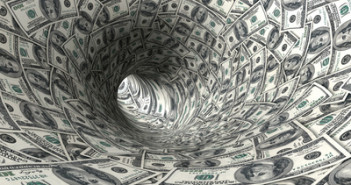US stocks suffered their second day of losses in a row, as better than expected data from the region continues to hint the Fed may be close to trimming down some of its monthly asset purchases. Commodities remained under pressure as the “taper-on†trade saw gold and oil well offered throughout the North American session; however foreign exchange markets were not so cut and dry, as DXY weakness showed currency traders weren’t scrambling to bid up the big dollar as one would expect in anticipation of slowing balance sheet expansion from the Federal Reserve.
The sour investor sentiment was echoed throughout the overnight Asian session, gathering momentum and stifling risk appetite across the board. The Nikkei plunged 4% after Japan pledged to halve its primary deficit on schedule, which could force the government to scale back some of its regional stimulus plans. The USDJPY sank along with the Nikkei, as yen strength pushed the pair to make a test of the 97 handle.
As we move into the European session, the big focus was on the Bank of England’s quarterly inflation report, and the subsequent forward guidance on monetary policy investors were expecting Governor Carney to unveil. The new BoE Governor is challenged by the fact that the central bank is looking to provide a monetary policy climate that is conducive of further economic growth, without continuing to froth already lofty consumer prices. In trying to tackle his precarious situation, Governor Carney divulged the MPC would not raise the overnight lending rate from its current level at least until the unemployment rate hit 7%, and that the central bank would undertake further asset purchases if it judges additional stimulus is required. Putting this into context, if job growth in the UK continues to stay on pace, it is likely the unemployment target won’t be reached until at least the last half of 2016, giving businesses and households the ability to borrow at low rates for quite some time. Markets initially responded favorably to the forward guidance, with the pound dropping 100pts against the USD as interest rate hike expectations were pushed out further than originally anticipated. However, after the remainder of the statement was digested, and traders caught wind of the three ‘knock-out’ clauses that made the guidance from Threadneedle Street less explicit, the pound unwound its earlier losses, and Cable spiked over 200pts to trade above the 1.54 handle. The so-called ‘knock-out’ clauses could make the unemployment threshold irrelevant, as the bank has stated that if inflation is judged to be 2.5% or higher 18-24 months out, inflation expectations become unanchored, or financial stability is compromised, then the forward guidance surrounding unemployment will become void. The conditionality surrounding the guidance, along with the current level of inflation, compromises the credibility of the anchoring low rates to unemployment, and has subsequently sent the pound soaring into the mid-1.54s.
Heading into the North American open, the economic release schedule was largely CAD centric, with both Building Permits and the Ivey PMI survey both on the docket. New building permits issued during the month of June were forecast to pause slightly from the recent string of solid gains, as the median analyst estimate was for the reading to slide by 2.5% over the previous month; however, in a drastic miss to the downside, the official number printed at -10.3%. Despite the worse than expected reading for building permits, this is still only the first decrease in six months, with the overall trend is still being to the upside. The disappointing data hasn’t done the Loonie any favors this morning, and after comments from Fed speakers yesterday hinted at tapering on the horizon, along with risk appetite evaporating during the equity sell-off in Asia, the USDCAD pair shot upwards and is currently making a test of resistance in the mid-1.04s.
Equity futures in North America are telegraphing we will get a slightly negative open to the trading session when the opening bell is rung, as investors are still on cautious footing after the bloodletting in Asia. Energy and Metals continue to struggle after yesterday’s weakness, with both WTI and Gold finding offers to drag them down as we get set for New York to open; WTI is sliding towards $105/barrel while Gold is edging lower to $1,275/ounce.
The survey of purchasing managers in the Canadian economy has been forecast to improve over last month, with the surprise slip to 55.3 in July looking to be partly reversed with a forecasted print of 56.3. The July numbers at due out at 10:00am EST, and should they come out on par with expectations (or an upside surprise), watch for the Loonie to potentially gain back some of its earlier losses.
Looking ahead to tomorrow, the Bank of Japan will issue its prescription for the appropriate course of monetary policy, and while markets are not expecting any changes to the BoJ’s stimulus program, the subsequent press conference and communication from Governor Kuroda will be closely watched by traders and investors alike. The last monetary policy press conference from Kuroda underwhelmed markets, as more hawkish than expected language and a ‘wait-and-see’ approach to its current accommodative stance disappointed yen bears, and has helped the USDJPY work its way back into the 97 region. It is most likely too early for Kuroda to inflate its asset purchase program, however should the BoJ Governor verbally strengthen his commitment of the central bank to hit its inflation target, there could be some renewed selling pressure in the yen.
Further reading:Â
GBP/USD Knockout – 200 pip round trip, and going – breaks 1.54
USD/CAD breaks above 1.04 – mostly due to the USD side of the pair



